People
Audiences Can’t Get Enough of California Artist Chelsea Ryoko Wong’s Paintings of Simple, Everyday Joys
The San Francisco artist has a string of strong recent shows.
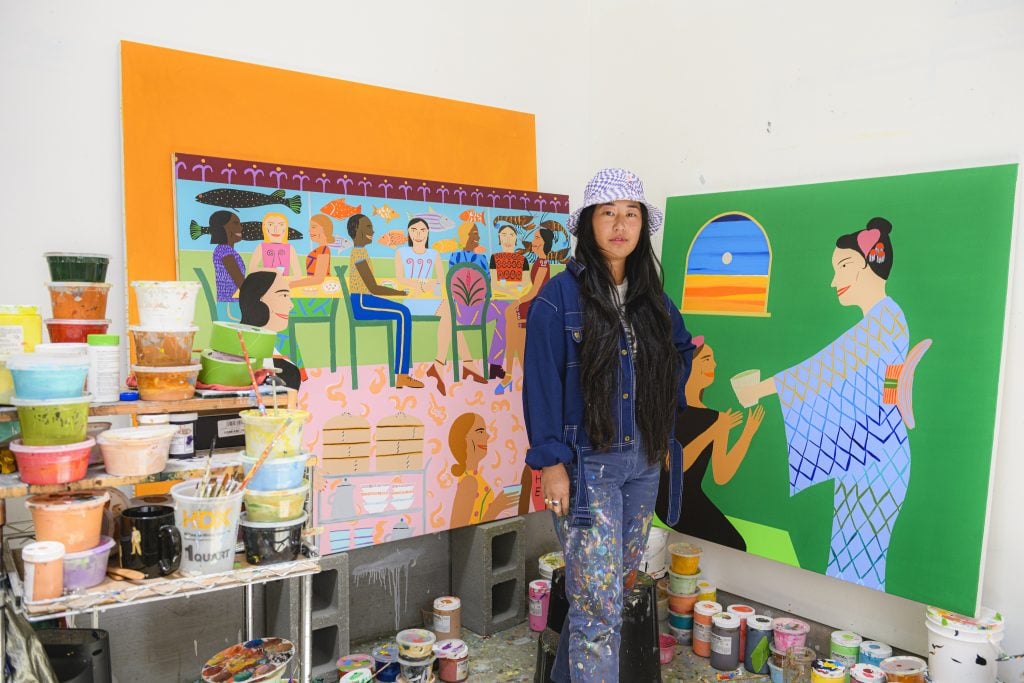
The San Francisco artist has a string of strong recent shows.

Jennifer Piejko

Our memory plays tricks on us—objectively, our most formative, definitive thoughts are probably a little amiss. Recollection is both static and active, a way of visiting the past and creating it for ourselves at the same time. When Chelsea Ryoko Wong made After the Dentist with Dad (2022), she painted not only from, but with, her memory: Her father is shown as he appears today, at 84 years old, while Wong depicted herself standing with him as a young child.
The buoyant roasted ducks swaying above the counter and cheerful, color-blocked tiles lining the storefront resemble the Chinatown facades of her home city of San Francisco, even though she draws on their father-daughter tradition of rewarding themselves with the Cantonese specialty as a way of getting through dentist visits in her native Seattle.
“I wanted to paint that moment, but I wanted to make it intergenerational,” Wong explained from her Mission District studio. “It’s a collage of memories past and present. Artists have the agency to create our own world, so my work is a mix of fact and fiction. I like to give people room for their own story in the image.”
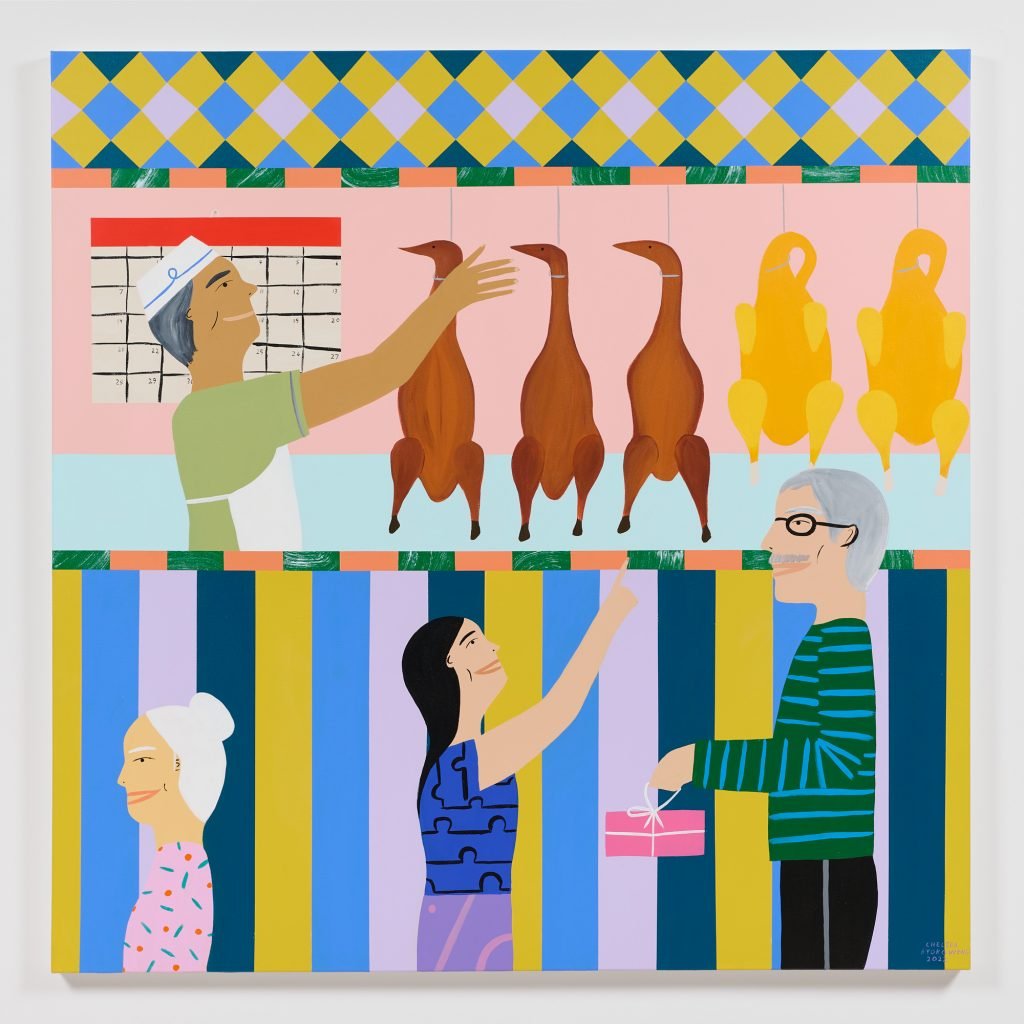
Chelsea Ryoko Wong, After the Dentist with Dad (2022). Photo: Glen Cheriton, Impart Photography; Courtesy of the artist and Jessica Silverman, San Francisco.
Many of the works (all done in 2022) in “Gravitational Pull,” her recent solo exhibition at Jessica Silverman in San Francisco, settle into similar composites that celebrate the simple, genuine pleasures of getting together. While works such as Fisherwomen and Mint Tea in the Sauna During Sunset reflect the care and intimacy that grow from quality one-on-one time, she is more known for scenes such as those in A Modern Feast, Musseling on a Foggy Day, and Joshua Tree With Friends. In these, diverse groups of loved ones and acquaintances are happy to share a meal or navigate California’s sublime natural terrains collectively.
These easygoing plans are an open invitation to the viewer: “She pays such close attention to the sizes of the figures [in these paintings],” Jessica Silverman said. “She makes it feel like we can all be in the painting with them.”
In a perpetual news cycle of division, violence, and social regression, reflecting true diversity and inclusion within one’s circles can seem like a radical, politically charged act. For Wong, it’s just the way it’s always been. Her father is a political science teacher from Hong Kong, whose family lived under Japanese occupation. Her mother is Japanese American, whose family spent time in US internment camps during World War II. Her three half-sisters are half Black and half Japanese.
“We all have very different origin stories, but we grew up as a family—and we’re still a family,” she said. Discussions around race and culture were standard dinner-table fare.
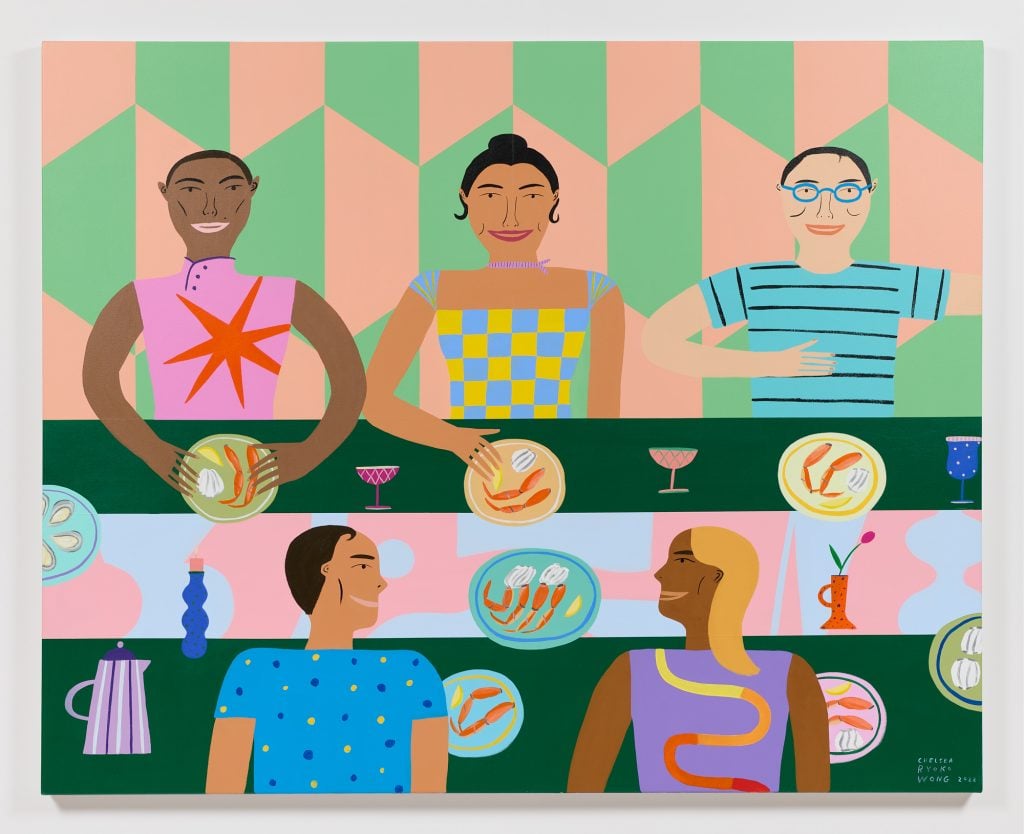
Chelsea Ryoko Wong, A Modern Feast (2022). Photo: Glen Cheriton, Impart Photography; Courtesy of the artist and Jessica Silverman, San Francisco.
Wong is also deeply rooted within her immediate surroundings, and her work ties to personal landmarks with site-specific and public works. The San Francisco activist collective 100 Days Action invited Wong to paint a lively mural showing the inside of Hon’s Wun-Tun Noodle House, one of her neighborhood standbys, onto the restaurant’s exterior when it was boarded up early on during pandemic lockdowns.
“I wanted people to have a connection to this place even though they couldn’t be open for business, and keep that presence up, given what it means for the Chinese community here,” Wong said.
She sees her work as a gesture of warmth and solidarity, in response to the escalated threats of violence directed at AAPI communities over the past two years. She is also adapted a painting of hers to adorn the Yetunde Price Resource Center, a community space in Compton, Los Angeles that provides counseling and healing through trauma-informed programs. It is named after the late older sister of Venus and Serena Williams, who was killed in 2003 in an act of gang violence in the neighborhood.
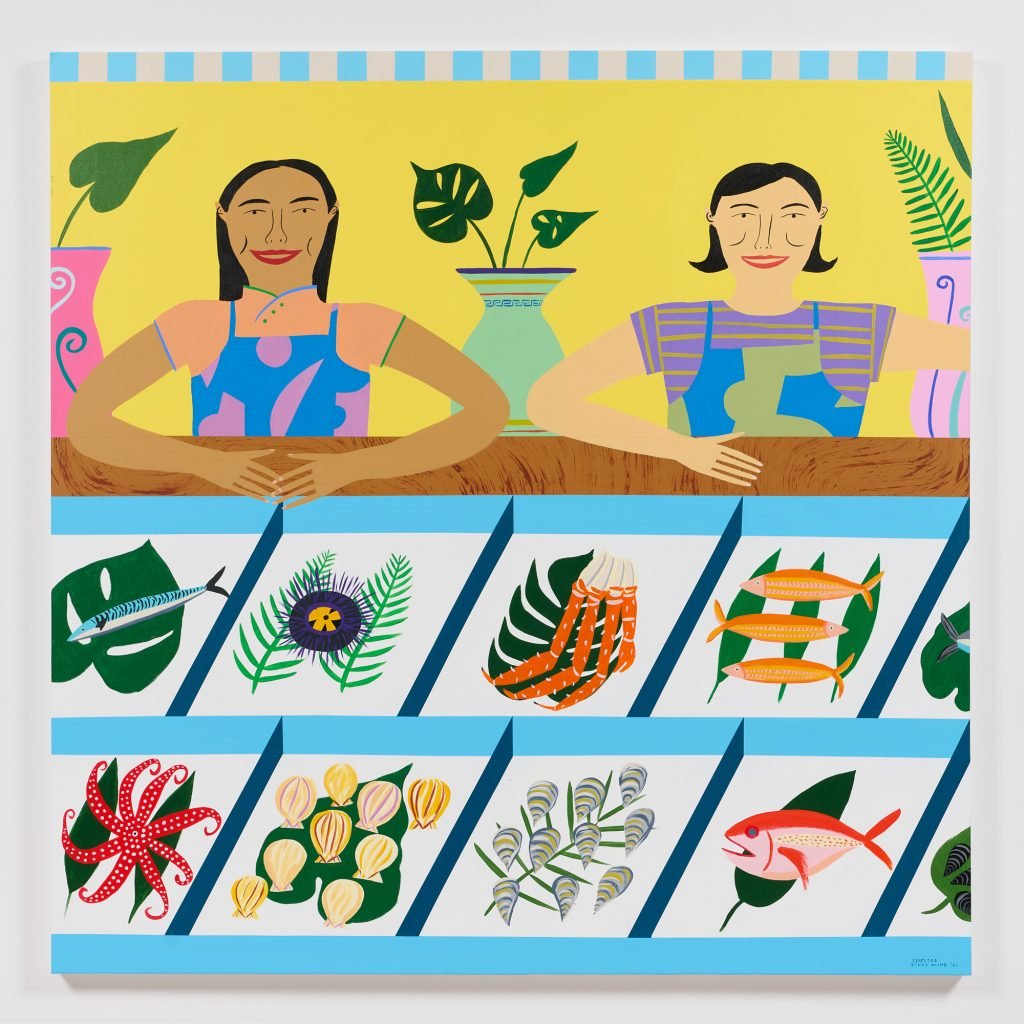
Chelsea Ryoko Wong, Fisherwomen (2022). Photo: Glen Cheriton, Impart Photography; Courtesy of the artist and Jessica Silverman, San Francisco.
Wong studied graphic design and illustration at Parsons in New York and California College of the Arts in Oakland to receive her BFA in printmaking. Though not formally trained in painting, her distinct style is instilled by her studies: She lays down flat layers in her painting similar to the technique used in making prints. “She’s [also] a great colorist,” Silverman said, describing how Wong likes to pair two discordant colors and challenge herself to realize one in the middle that brings all three together in visual harmony.
The gallerist became drawn to Wong’s work in 2020, making masked visits to her studio when Covid forced so many aspects of society—and socializing—to slow down. Perhaps unintentionally, Silverman was also drawing on another thread of hyperlocal record: The Mission School artists that came out of the San Francisco Art Institute in the 1990s and 2000s, including Barry McGee, Chris Johanson, Ruby Neri, and Claire Rojas. Considered part of the lowbrow art movement, their work gave the area its unique murals, graffiti, comics, and folk art, and though the group emphasized accessibility and nimble methods and materials, such as spray paint, they often lacked in representation.
“I had been thinking a lot about the Mission School imagery,” Silverman said. “I think of Chelsea’s work as an update to that, which had mainly been about white bodies.”
More women floated by behind the artist during our FaceTime studio visit. She was working on a painting of women relaxing in the water and drying their traditional cheongsam dresses on the flat rocks jutting out of the Yuba River, a former Gold Rush settlement near Sacramento. I see a copy of Forbidden City, USA: Chinese American Nightclubs, 1936–1970, a history of the nightlife scene of 1930s and 40s San Francisco, on her desk.
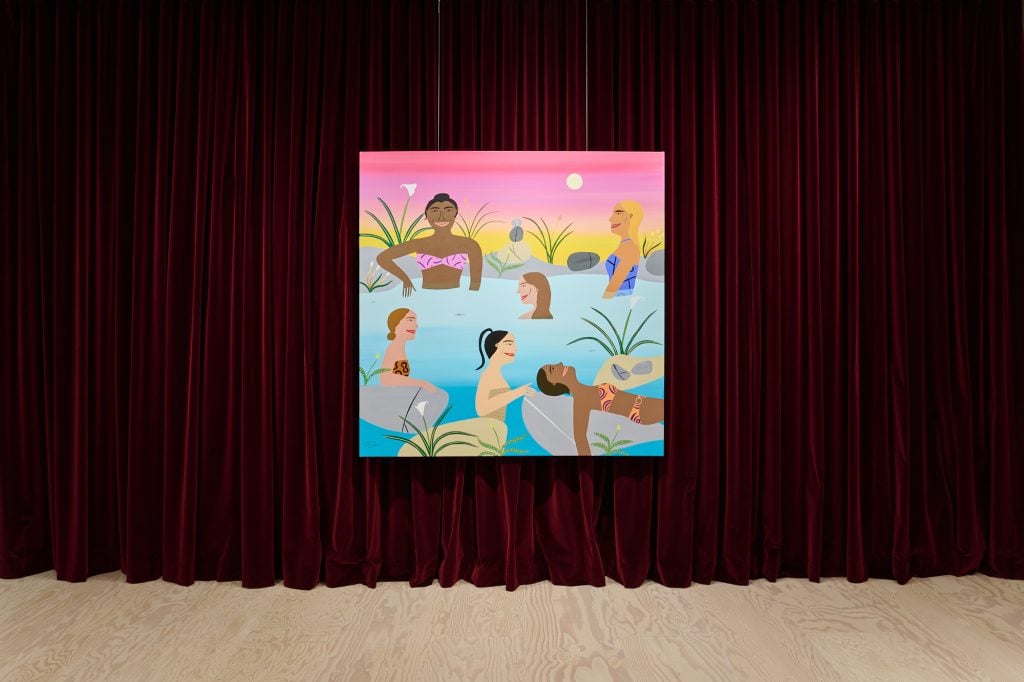
Chelsea Ryoko Wong, Bathing Beauties, 2022. Photo: Glen Cheriton, Impart Photography; Courtesy of the artist and Jessica Silverman, San Francisco.
“[Asian] Women weren’t really allowed to come to the U.S. at that time, and there was so much racism against Chinese people,” Wong said, referencing the Chinese Exclusion Act of 1882. “I’m reimagining this time so that these women can live their best life,” Wong laughs.
The work in progress is featured in “Wonder Women,” an exhibition about the self and identity seen in figurative art, as well as the gifts of magic and wonder, with work by Asian American and diasporic women and non-binary artists, on view at Deitch’s New York location. “Chelsea’s works depict the everyday joys that exist in Asian American communities across the U.S., and I felt that her voice was essential to include here,” says Deitch Managing Director and “Wonder Women” curator Kathy Huang.
“Wonder Women” and “Gravitational Pull,” as well as “Manta,” a two-person show at New Image Art in Los Angeles, are the most recent in a string of back-to-back commissions and projects for Wong. This summer, she’ll also be in Silverman’s group show at TOA Presents, the exhibition space by The Orange Advisory, an art consultancy in Minneapolis. Wong is also nominated for the San Francisco Museum of Art’s SECA Art Award, an annual celebration of emerging Bay Area artists who are shortlisted for a presentation at and publication by SFMoMA in December.

Chelsea Ryoko Wong, Joshua Tree With Friends (2022). Photo: Glen Cheriton, Impart Photography; Courtesy of the artist and Jessica Silverman, San Francisco.
Sales of her work are also gaining momentum. Though her current exhibition includes just seven paintings, priced between $10,000 and $15,000, Silverman has already fielded over 30 inquiries. “We thought that either collectors who support our program would be interested in her work, or that Chelsea’s own loyal following would lead us to new collectors. Both of those things happened,” Silvermans said. The gallery is now finalizing Wong’s first institutional acquisition.
And given the artist’s mapping of her state’s dreamlike topography, she may already have her next point of inspiration. At the end of our interview, Wong was leaving the studio a little early to head to Point Reyes, where her friends were crabbing on the shore.